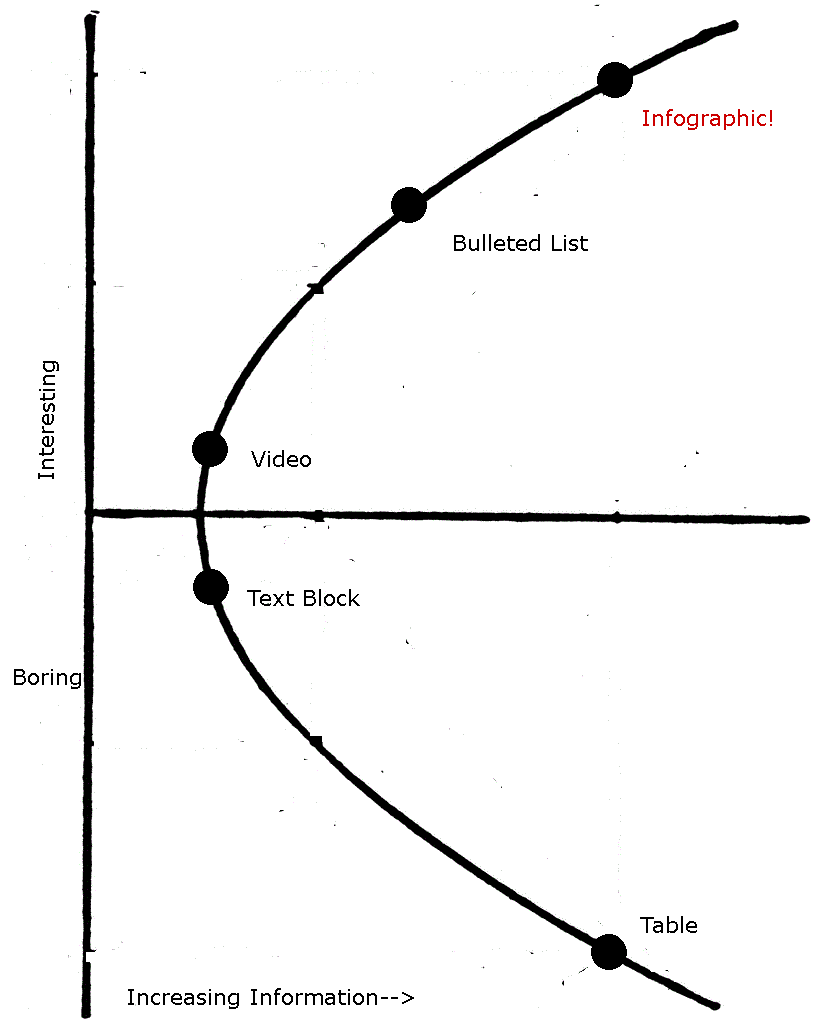It’s one of the cliches you hear in every writing class: “Show, don’t tell.” I’ve spent many hours arguing with writing teachers that what they call “showing” is really just another way of telling. However, with infographics, you have the opportunity to really show potential customers important information about your service, goods, or practice. Properly used, infographics can educate your customers, increase your exposure, enhance your brand, and increase conversions.
The first couple sections are basic primers on why you should use infographics, but if you’re already sold on the idea, skip down to the third section to learn how to use them well.
Edutaining the Masses
Most people know nothing about your product or service when they first consider it. They often need a lot of background information before they can even consider whether they want to buy from you or a competitor. But the last thing most people want to do is slog through a bunch of dense prose to learn the information they need. Instead, you have to find more interesting ways to present your information that is both educational and entertaining. Fortunately, some of the best ways to communicate information are also some of the more interesting, as you can see from the edutainment parabola.

Okay, so I just made that up, but hopefully I communicated my point. When you have to communicate information to prospective clients, there are many ways to do it. Some are interesting. Some are boring. When you have a lot of information to communicate and want to do it in an interesting way, nothing’s better than an infographic, for some types of information.
(A note about video. I give it low marks for both interest and information power. If you try to explain complex information in a video, you end up boring your audience, and often people will have to rewind several times to understand what was said. So what do you do? You put a graphic in. And then you end up with basically the same thing as a static graphic, except that it goes by too fast for some or lingers too long for others. A static graphic allows people to scan the image quickly, learn what they want, and easily come back for more. Video is not a good tool for communicating information, it’s better for other things, especially as a relation-building tool.)
Harnessing Social Media (and Beyond)
Another great thing about infographics is that when they’re interesting and well designed, they are very shareable. People love to pass around effective, interesting, and humorous infographics, as well as their relative, the pithy e-Card. While an article or blog might get you a few shares that diminish fairly quickly, infographics can get hundreds of shares, and they’re more likely to last years, cycling around and around groups that are interested in your product or service, people who are looking for more information to give them the confidence they need to make a purchase.
Social media is also a great way to get your content picked up by high-profile news outlets, aggregators, and blogs. If you are offering valuable insight with your infographic, it may be used by major name-brand domains, giving you valuable links that can significantly improve your site’s SEO.
Effective Infographics
Effective infographics should be:
- Unique
- Compelling
- Moderately sized
- Targeted
- Branded
- Visible
Unique infographics are the only kind worth sharing on your site. There are many websites out there offering to give you free infographics. All you have to do is embed the code in your blog and boom–there it is. Unfortunately, these are old infographics, often with basic designs, old information, and overall a tired appearance. Novelty drives infographic sharing, and the only way to get novelty is to make it yourself.
Compelling infographics build tension. It’s easy to just throw a bunch of random information on the page, but to make your infographic truly effective, it needs to tell a story of some sort. Basic narrative arcs that you can construct for an infographic include: general to specific, large to small, and public to personal. Use language to spin the data to guide your readers emotionally, because it doesn’t always speak for itself.
The right size for infographics is important. On the internet, infographics can be virtually any size, but you have to make sure you don’t make them too large for your narrative, or people will lose interest. Long, skinny scrollers are especially susceptible to this. People lose interest and stop scrolling down before they get to the end. Make sure every screen has at least one “zinger,” a compelling piece of information that can re-ignite interest.
Targeted infographics are designed to answer specific questions and concerns people have about your product or service. How do you find these questions? One way is to look at the search traffic to your site. People often put questions to Google or Bing, so searching for question words (who, what, where, when, why, or how) among the keyword searches in your Google Analytics will help you identify them. Or if you don’t have enough traffic to give you a good idea of the questions, you can visit forums for people discussing your product. You’ll find plenty of questions there. Targeting your infographics will ensure you get relevant traffic from them.
Branding your infographics is crucial. You want people to associate your practice with your infographic. At a minimum, this means putting your practice name and logo on the infographic, but it also means capturing the same tone on your infographic that you present on your site.
Lastly, you have to make sure your infographics are visible. If you have a good amount of traffic to your site or your blog, you can put it there. If not, find a blog with better exposure and offer your infographic as a guest post.
The Right Tool for the Right Job
And it’s important to remember that infographics are really only best for communicating certain types of information. They work best to communicate background information that shouldn’t be clogging up your main website content.
Infographics aren’t really selling tools. Don’t expect them to bring in leads directly. But they can bring people to your site where they can read more directly about your practice and make a decision. Their ability to harness social and even traditional media make them a powerful complement to your primary site content.

